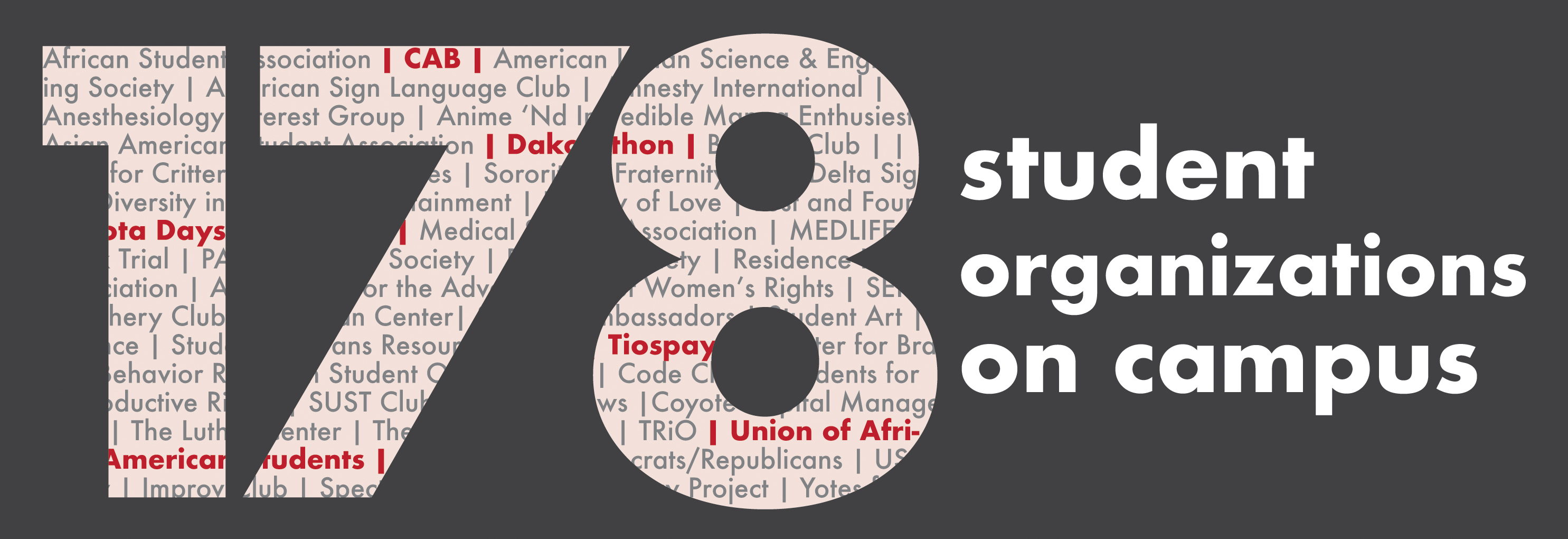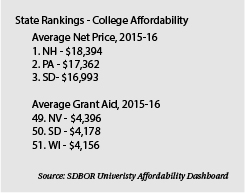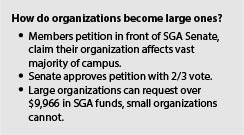
Population and participation: The inverse relationship at USD
This is part one of a two-part series looking into participation in student organizations across campus.
The University of South Dakota has no issue attracting students to Vermillion. Student enrollment has maintained between 9,500 and 10,000 since 2014, and last fall the school introduced its largest class of incoming first-year students.
But miscommunication exists between campus organizations and the student body on what to do after students step foot on campus, and organizations are suffering from a lack of membership.
Of 5,600 students attending classes on campus, only 30 percent are registered with a student organization, according to USD Involved, a portal that centralizes all USD organizations into one website. Organizations are required to register their president, advisor and five members into USD Involved. Registering members beyond that is up to the organization and its members.
A reduction in involvement threatens the quality and longevity of a student organization. Their prosperity relies on a student body whose investment in campus reaches deeper than schoolwork, Sorbe said.
“I just think students are just not invested beyond that, which is sad,” Josh Sorbe, 2018-19 Student Government Association President, said. “I have heard it was a lot worse. We used to be a huge ‘suitcase’ campus, where people would stay in the dorms Monday through Friday and go home every single week. Apparently, that culture has gotten a lot better, but it’s still not great.”
Affordability
Sorbe said he believes a big sector of students don’t join organizations on campus simply because they can’t afford to. Most organizations don’t charge dues, but they do charge time. Time that can be spent securing financial stability through employment.
“Systemically, I think it might be difficult for people to get fully involved in campus life and being a leader on campus. It is very expensive to go to college and you don’t get paid to do stuff like this,” he said. “We always market that we’re a very affordable college because we have a low sticker price, but the price we pay on our bills is the third highest in the nation because we get so little need-based aid from the state.”
In 2015-16, the average cost to attend a South Dakota university was just under $17,000 annually. South Dakota also ranked second lowest in average grant aid– state dollars allotted to students for post-secondary education ($4,178 per student). 
USD introduced reciprocity with six surrounding states in January, reducing costs for the 40 percent of non-resident students enrolled on campus. But mere proximity is still a problem for out-of-state students searching for connections on campus, Sorbe said.
“We’re recruiting a lot more Iowa and Minnesota students, and a lot of the time people who get involved in college say ‘I had an older sibling that did this’ or ‘I knew someone was involved in this,’” he said. “Informal recruiting is awesome, but a lot of students come here without those kinds of connections, and it breeds a culture of ‘who you know.’ That’s the nature of South Dakota, it is about who you know because it’s a very small, tight-knit community, but it is hard for people who don’t have those kinds of connections to get involved.”
Large vs. Small Organizations
Of the 178 organizations recognized by USD, five are considered “large organizations.” These five are Dakotathon, Union of African American Students (UAAS), Tiospaye, the Dakota Days Committee and the Campus Activites Board (CAB).
Large organizations aren’t subject to the same type of instability small organizations face. They do receive larger allotments from SGA, but that doesn’t mean small organizations are funded less.
In 2018, SGA funded 77 student organizations, 23 more than the previous year. Large organizations used 93.98 percent of their allotted funds. Small organizations used only 57.77 percent.
“We haven’t been strapped for money in SGA. If someone asks for money, unless they ask for $1,000 for pizza, we usually fund in full,” Sorbe said. “The problem is, we have a lot more organizations being funded, but look how much they use their money.”

Hannah Booth, SGA Vice President and sophomore political science and criminal justice double major, said the new SGA executive team has built a platform to educate organizations on funding.
“It’s definitely a miscommunication. A lot of student organizations don’t really understand how SGA affects them or how we can benefit their organization,” she said.
In addition to funding confusion, small organizations sometimes destabilize themselves at their founding, Sorbe said. Some aren’t built to last.
“A lot of organizations don’t form to be systemic, they form because a group of friends wants to do something and call it an organization, and the organization dies in two or three years, which is unfortunate,” he said.
The core of an organization is its mission, and large organizations have, what Teagan McNary, a fifth-year political science major and 2017-18 Student Government Association President, referred to as “cause-connection.”
“A lot of big student organizations have made a name for themselves in getting a wide variety,” she said. “People involved in Dakotathon put a lot of time into Dakotathon even though they’re not going into the health field or doing anything in that sense, but they’ve found that cause-connection and for a lot of other student organizations, they don’t have that.”
‘Campus Elite’
When organizations do possess a “cause-connection,” or a “clear-cut purpose,” as Josh Anderson– a former SGA Vice President and senior political science and business double major–puts it, the next step is carrying that purpose out. However, faltering participation puts the heavier weight on fewer shoulders, creating a group with an unproportionate influence and responsibility in comparison to the rest of the student population.
“There’s a small subset of the student population in those organization’s leadership positions,” Anderson said. “You see people that are on executive board for multiple organizations. It’s the same exact people.”
Anderson, an example of this concept, is a student ambassador, but also served as president of Tau Kappa Epsilon while in the SGA VP position. He, along with Sorbe, said organizations, including SGA itself, experience these internal problems.
“What do we do? We can get five people to do something, but what do we do outside that reach?” he said. “Everyone says ‘oh, get food at your meetings.’ That doesn’t fix the problem. You need people to have an actual investment who want to do something.”
“You have the executive staff and committee chairs doing everything, and then you have people just sitting there voting yes and no,” Sorbe said about weekly SGA meetings. “It’s probably a prioritization thing, but I’ve always gotten way more out my extra-curriculars than I have my classes.”
McNary, whom Anderson served with, said apathy within an organization is a problem you’ll find anywhere.
“It would be phenomenal if SGA was full of 25 students that were so excited and so passionate and wanted to be nowhere else except meetings Tuesday nights, but that’s not gonna happen,” she said. “When you go into the real world and look at a company, there are always going to be people who work really hard and are really passionate about it, and people who are ‘oh, it’s a good opportunity for me, so I’m going to do what I need to do to be here, but I’m really not going to do more than that.’”
Most organizations are built on a small core of students, and sometimes, that’s okay, McNary said. But when that central group doesn’t interact with the rest of campus, it shuts out other students seeking involvement, said Sydney Schad, a senior health sciences major and member of Tiospaye and the American Indian Science and Engineering Society (AESIS).
“Organizations that I’m involved in have the same trends of people. It is this group of people that everyone knows who they are and what they’re doing,” Schad said. “It shouldn’t be like that. When you have that close-knit group inside an organization, it’s hard to disband it to bring in new people. I think we get to a certain level of comfort, and I don’t think we challenge ourselves enough to teach others.”
Turnover
What happens when that core group moves on or graduates without educating its successors? A student, if they begin to participate with an organization their first year, only gets four years to make a change. In terms of leadership, most organizations only give semester or yearlong terms to its executive staff.
“In terms of SGA, you have one year on the executive team and half of that year is just figuring out what you’re doing,” McNary said. “And then the last two months you’re like ‘heck yeah!’— and then you’re done.”
That’s where the role of the advisor is important, McNary said.
“Large organizations generally have a good relationship with their advisors. I think people downplay the role of advisors a lot in student organizations,” she said. “There’s turnover every year, and the only thing that stays constant is the advisors.”
Most organizations are advised by faculty members, and expecting professors and instructors to increase advising roles whilst conquering education duties is unrealistic, McNary said. Though, promoting organizations inside the classroom is a help.
“I think that’s a barrier we run into. Faculty and advisors, their full-time job is not to ensure that this org and their mission is successful,” she said. “I know that it’s hard because there’s already so much we need to learn and there’s always limited time for everything. But incorporating the two could help.”
McNary used the Center for Diversity and Community (CDC) to portray the outcomes of active advising. The CDC staff consists of professional programmers whose jobs are to implement and promote events on campus. The Ruby Ball, an event hosted by the Union of African American Students (UASS) on Saturday, illustrated the positive effect, McNary said.
“I think of an example of a student organization that has built themselves up in my time of being here: look at the Union of African American Students. They kill it. Always,” she said. “They just had their Ruby Ball Saturday night. 200 people that paid $10 for tickets on a Saturday night, no booze. That’s pretty cool. It was about unity. It was like ‘yeah, we all wanted to have fun,’ but there was a message behind the organization.”
Part two of the series discusses the freshman perspective, the implication of Greek Life, and USD culture surrounding involvement.

